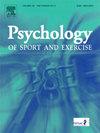每日睡眠、身体活动和久坐行为与情绪的前瞻性关联:贝叶斯多层成分数据分析。
IF 3.3
2区 心理学
Q2 HOSPITALITY, LEISURE, SPORT & TOURISM
引用次数: 0
摘要
背景:24小时行为(睡眠、在床上醒着的时间、中高强度身体活动[MVPA]、轻度身体活动[LPA]和久坐行为[SB])可能通过与日常生活中的情感体验相关而影响长期心理健康。在这里,我们调查了每天24小时行为和情绪之间的前瞻性关联。方法:连续7-15天收集健康社区居民(N=354,年龄为22.61岁,73%为女性)的24小时行为和自我报告的影响数据,提供2872天的数据。贝叶斯多层成分数据分析评估了行为之间重新分配时间如何与人与人之间和人与人之间的第二天影响相关。结果:24小时行为与第二天影响之间的关联出现在个人内部,而不是个人之间。相对于其他行为,较多的LPA预测较高的高唤醒积极情绪(0.14 [95% CI 0.03, 0.26]),较少的SB预测较低的高唤醒和低唤醒积极情绪(分别为-0.12[-0.24,-0.01]和-0.13[-0.25,-0.02])和较高的高唤醒负情绪(0.13[0.03,0.24])。此外,人体内30分钟内从SB、睡眠和醒在床上的时间重新分配到LPA也预测了≥0.03[0.00,0.06]更高的高觉醒积极影响。再分配时间30分钟后,高唤醒性正面情绪会增加0.04[0.01,0.06],低唤醒性负面情绪会降低-0.02[-0.04,-0.00]。结论:研究结果为确定健康个体24小时行为的最佳日常组成提供了踏脚石证据。应该在日常环境和临床人群中对LPA和MVPA替代SB时间以改善情绪进行实验测试,从而为更好的日常情绪和心理健康的诊断和干预策略提供信息。本文章由计算机程序翻译,如有差异,请以英文原文为准。
Daily, prospective associations of sleep, physical activity, and sedentary behaviour with affect: A Bayesian multilevel compositional data analysis
Background
24 h behaviours (sleep, time awake in bed, moderate-to-vigorous physical activity [MVPA], light physical activity [LPA], and sedentary behaviour [SB]) may influence long-term mental health through their associations with affective experiences in everyday life. Here, we investigated the daily, prospective associations between 24 h behaviours and affect.
Methods
Actigraphy-measured 24 h behaviours and self-reported affect data were collected across 7–15 consecutive days in healthy, community-dwelling adults (N = 354, Mage = 22.61 y, 73 % female) providing 2872 days of data. Bayesian multilevel compositional data analysis evaluated how reallocating time between behaviours was associated with next-day affect at between- and within-person levels.
Results
Associations between 24 h behaviours and next-day affect emerged at the within-person, not between-person level. Relative to the remaining behaviours, more LPA predicted 0.14 [95 % CI 0.03, 0.26] higher high arousal positive affect, whereas less SB predicted lower high and low arousal positive affect (−0.14 [-0.25, −0.02] and −0.12 [-0.24, −0.01], respectively) higher high arousal negative affect (0.13 [0.03, 0.23]). Further, within-person 30-min reallocation to LPA from SB, sleep, and time awake in bed also predicted ≥0.03 [0.00, 0.06] higher high arousal positive affect. 30-minute reallocation of time to LPA and MVPA from SB predicted 0.04 [0.01, 0.06] higher high arousal positive affect and −0.02 [-0.04, −0.00] lower low arousal negative affect.
Conclusion
Findings provide stepping stone evidence for identifying optimal daily compositions of 24 h behaviours for affective enhancements in healthy individuals. Replacing time in SB with LPA and MVPA for improving affect should be experimentally tested in daily settings and clinical populations, to inform diagnostic and intervention strategies for better daily affect and mental health.
求助全文
通过发布文献求助,成功后即可免费获取论文全文。
去求助
来源期刊
CiteScore
6.40
自引率
5.90%
发文量
172
审稿时长
69 days
期刊介绍:
Psychology of Sport and Exercise is an international forum for scholarly reports in the psychology of sport and exercise, broadly defined. The journal is open to the use of diverse methodological approaches. Manuscripts that will be considered for publication will present results from high quality empirical research, systematic reviews, meta-analyses, commentaries concerning already published PSE papers or topics of general interest for PSE readers, protocol papers for trials, and reports of professional practice (which will need to demonstrate academic rigour and go beyond mere description). The CONSORT guidelines consort-statement need to be followed for protocol papers for trials; authors should present a flow diagramme and attach with their cover letter the CONSORT checklist. For meta-analysis, the PRISMA prisma-statement guidelines should be followed; authors should present a flow diagramme and attach with their cover letter the PRISMA checklist. For systematic reviews it is recommended that the PRISMA guidelines are followed, although it is not compulsory. Authors interested in submitting replications of published studies need to contact the Editors-in-Chief before they start their replication. We are not interested in manuscripts that aim to test the psychometric properties of an existing scale from English to another language, unless new validation methods are used which address previously unanswered research questions.

 求助内容:
求助内容: 应助结果提醒方式:
应助结果提醒方式:


